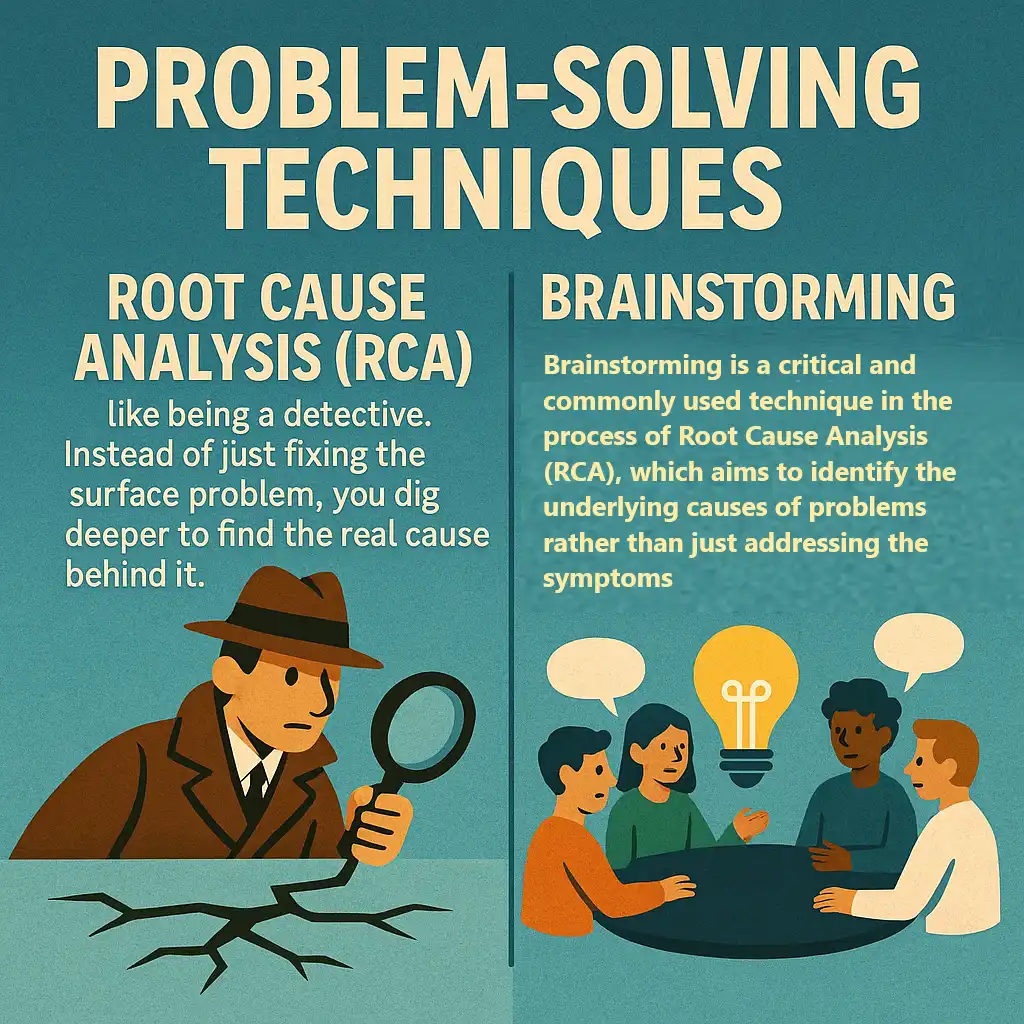Problem-Solving Techniques in simple, easy-to-understand terms. Think of problem-solving as the process of finding the best solution to a challenge, whether it’s fixing a broken phone, managing a project, or deciding what to eat for dinner.

Root Cause Analysis (Finding the Real Problem)
What is it?
Root Cause Analysis (RCA) is like being a detective. Instead of just fixing the surface problem, you dig deeper to find the real cause behind it.
Why it’s important:
If you only fix the symptoms, the problem might come back. RCA helps you solve it for good.
How to Do It:
- Ask “Why?” repeatedly: This is called the 5 Whys Technique.
- Identify the problem clearly.
- Analyze what’s causing it.
- Find the root cause.
Example:
Problem: “The coffee machine isn’t working.”
- Why? “Because it’s not turning on.”
- Why? “Because the power cord is damaged.”
- Why? “Because it was pulled too hard and got frayed.”
- Why? “Because the cord was too short, causing strain.”
- Why? “Because the machine design didn’t consider cord length properly.”
Root Cause: Poor design of the power cord length.
Brainstorming (Generating Lots of Ideas)
What is it?
Brainstorming is like having a creative party where everyone’s ideas matter—no matter how wild or strange they seem. The goal is to come up with as many ideas as possible without judging them.
Why it’s important:
It helps you think outside the box and discover solutions you might not have considered.
How to Do It:
- Gather a team (or work alone if needed).
- Define the problem clearly.
- Start sharing ideas freely. No idea is too crazy!
- Write down everything.
- Later, review and pick the best ideas.
Example:
Problem: “How do we reduce stress during team meetings?”
Brainstorming ideas could include:
- Starting with a 5-minute relaxation exercise
- Using fun ice-breakers
- Allowing short breaks every 30 minutes
- Creating a “no judgment” rule
- Playing calming background music
Decision Making (Choosing the Best Solution)
What is it?
Decision-making is about picking the best option from the ideas you’ve gathered. It’s like choosing the right tool from your toolbox—one that fits the job perfectly.
Why it’s important:
Good decision-making helps you avoid mistakes and move forward confidently.
How to Do It:
- List the possible solutions.
- Evaluate each option:
- What are the pros and cons?
- How feasible is it?
- What are the risks?
- Consider the impact: Will it solve the problem effectively?
- Make your choice.
- Act on it and review the outcome later.
Example:
From the brainstorming session on reducing team stress:
- Option 1: Start with relaxation exercises (pro: calming; con: time-consuming)
- Option 2: Fun ice-breakers (pro: engaging; con: not everyone likes them)
- Option 3: Short breaks (pro: refreshes energy; con: might interrupt flow)
Decision: Choose the option that balances effectiveness and feasibility—maybe a mix of relaxation exercises and short breaks.
- Root Cause Analysis: Find out what’s really causing the problem.
- Brainstorming: Generate lots of ideas without judgment.
- Decision Making: Choose the best solution from the ideas.
Tags: 5 Whys Technique, analyzing problems, and process improvement., Brainstorming, brainstorming session, creative solutions, creative thinking, critical thinking, Decision Making, decision-making process, decision-making skills, effective problem-solving, finding solutions, idea evaluation, identifying the real problem, practical problem-solving skills, problem-solving, problem-solving steps, Problem-Solving Techniques, root cause, Root Cause Analysis, solution generation, solution selection, strategy development, team collaboration, team meetings, troubleshooting


